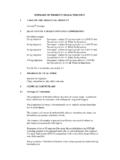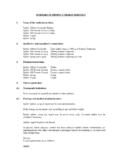Transcription of SUMMARY OF PRODUCT CHARACTERISTICS - Sanofi
1 SUMMARY OF PRODUCT CHARACTERISTICS 1 name of the medicinal PRODUCT Depakote 250mg Tablets. Depakote 500mg Tablets. 2 Qualitative and quantitative composition Containing of valproate semisodium* per tablet (equivalent to 250mg of valproic acid). Containing of valproate semisodium* per tablet (equivalent to 500mg of valproic acid). *Valproate semisodium is a stable coordination compound comprised of sodium valproate and valproic acid in a 1:1 molar relationship. It is also known as divalproex sodium (USAN). For a full list of excipients, see section 3 Pharmaceutical form 250mg: Oval, orange gastro-resistant tablets.
2 500mg: Oval, lilac pink gastro-resistant tablets 4 Clinical particulars Therapeutic indications Treatment of manic episode in bipolar disorder when lithium is contraindicated or not tolerated. The continuation of treatment after manic episode could be considered in patients who have responded to Depakote for acute mania Posology and method of administration For oral administration. The tablets should be swallowed whole with a drink of water, and not crushed or chewed. The daily dosage should be established according to age and body weight.
3 The wide variation in individual sensitivity to Depakote should also be considered. Dosage Manic episodes in bipolar disorder: Adults The daily dosage should be established and controlled individually by the treating physician. The initial recommended daily dose is 750 mg. In addition, in clinical trials a starting dose of 20 mg valproate/kg body weight has also shown an acceptable safety profile. Prolonged-release formulations can be given once or twice daily. The dose should be increased as rapidly as possible to achieve the lowest therapeutic dose which produces the desired clinical effect.
4 The daily dose should be adapted to the clinical response to establish the lowest effective dose for the individual patient. The mean daily dose usually ranges between 1000 and 2000 mg valproate. Patients receiving daily doses higher than 45mg/kg/day body weight should be carefully monitored. Continuation of treatment of manic episodes in bipolar disorder should be adapted individually using the lowest effective dose. Elderly Although the pharmacokinetics of Depakote are modified in the elderly, they have limited clinical significance and dosage should be determined on the basis of clinical response.
5 Children and adolescents The safety and effectiveness of Depakote for the treatment of manic episodes have not been studied in individuals below the age of 18 years. In patients with renal insufficiency It may be necessary to decrease dosage. Dosage should be adjusted according to clinical monitoring since monitoring of plasma concentrations may be misleading (see section Pharmacokinetic Properties). In patients with hepatic insufficiency Salicylates should not be used concomitantly with Depakote since they employ the same metabolic pathway (see also sections Special Warnings and Precautions for Use and Undesirable Effects).
6 Liver dysfunction, including hepatic failure resulting in fatalities, has occurred in patients whose treatment included valproic acid (see sections Contraindications and Special Warnings and Precautions for Use). Salicylates should not be used in children under 16 years (see aspirin/salicylate PRODUCT information on Reye s syndrome). In addition in conjunction with Depakote, concomitant use in children under 3 years can increase the risk of liver toxicity (see section Special warnings). Combined Therapy When starting Depakote in patients, already on anticonvulsants, these should be tapered slowly; if clinically possible; initiation of Depakote therapy should then be gradual, with target dose being reached after about 2 weeks.
7 Faster titration may be permissible if plasma level monitoring is available. In certain cases it may be necessary to raise the dose by 5 to 10mg/kg/day when used in combination with anticonvulsants which induce liver enzyme activity, phenytoin, phenobarbital and carbamazepine. Once known enzyme inducers have been withdrawn it may be possible to maintain control on a reduced dose of Depakote. When barbiturates are being administered concomitantly and particularly if sedation is observed the dosage of barbiturate should be reduced. When using Depakote with other psychotropics, a reduced dose may be required, (see Effects of Depakote on other drugs) Optimum dosage is mainly determined by control.
8 However, a method for measurement of plasma levels is available and may be helpful where there is poor control or side effects are suspected (see section Pharmacokinetic Properties). Contra-indications Active liver disease Personal or family history of severe hepatic dysfunction, drug related Hypersensitivity to valproate semisodium or any other ingredient of the preparation. Porphyria Special warnings and precautions for use To ensure the correct medication is prescribed for the patient s condition, care must be taken not to confuse Depakote with Epilim or sodium valproate.
9 Patients with bipolar disorder and epilepsy are distinct populations. These differences are reflected in the patient information leaflets which clearly indicate specific indications for these differing medications. Although there is no specific evidence of sudden recurrence of underlying symptoms following withdrawal of valproate, discontinuation should normally only be done under the supervision of a specialist in a gradual manner. This is due to the possibility of sudden alterations in plasma concentrations giving rise to a recurrence of symptoms. NICE has advised that generic switching of valproate preparations is not normally recommended due to the clinical implications of possible variations in plasma concentrations.
10 Special Warnings Liver dysfunction: Conditions of occurrence: Severe liver damage, including hepatic failure sometimes resulting in fatalities, has been very rarely reported. Experience in epilepsy has indicated that patients most at risk are infants and in particular young children under the age of 3 and those with severe seizure disorders, organic brain disease, and (or) congenital metabolic or degenerative disease associated with mental retardation. After the age of 3, the incidence of occurrence is significantly reduced and progressively decreases with age. The concomitant use of salicylates should be avoided in children under 3 due to the risk of liver toxicity.






